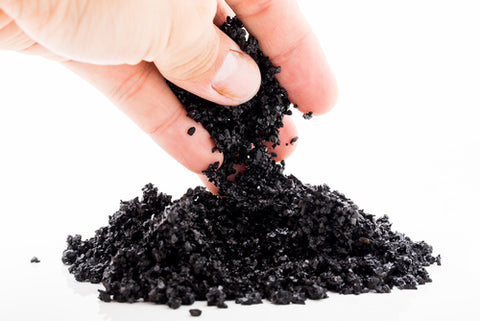Activated charcoal filters are one of the marvels of the modern age. They can be found in vacuum cleaners, ovens, air purifiers, compost pails, and even trash cans. These black squares of magic can take even the most disgusting odor and reduce it to nothing more than a bad memory. Whether you fry fish or you like to smoke cigars, activated charcoal is the key to making sure that your visitors don’t have to smell it.
Not only that, but activated charcoal works its magic in water filters as well, removing impurities and bad taste. And after your tap water has been filtered, it becomes clean, fresh, and tastes just like fresh water should.
But how do these near-magical filters work to eliminate the odor? The key lies in the little bits of charcoal scattered throughout the black mesh. The charcoal has been activated and becomes super porous. This means that a measly gram of activated carbon can have a total surface area of over 500 square meters. That’s nearly 125 acres of surface per pound of activated charcoal. This surface area amount is important because of how carbon removes impurities from whatever is flowing around it.
The Power of Adsorption

Carbon by itself is a powerful adsorbing agent. That’s adsorb with a ‘d.’ In absorption – with a ‘b’ – foreign particles are drawn into something, whether it’s a solid material or a liquid. Think of the silica gel packets that you find in electronic packaging. The silica gel absorbs water from the air and locks it into the gel.
In adsorbtion, foreign particles adhere to the surface of the adsorbing agent, they don’t penetrate it. This means that when something organic comes in contact with the surface, the carbon atoms grab onto it, causing these impurities to stick to it. So naturally, the more surface area that a piece of carbon has, the more stuff it can convince to stay with it.
So things that smell bad, like fried fish? The bad smell is caused by oils in the air. These volatile oils that cause the bad smell are attracted to carbon. When the air is rushed over the activated carbon, the oils stick to it and all that’s left coming out the other end is clean and fresh air.
When it comes to purifying your water, the same principle applies. The various things in your water that leave behind a bad aftertaste are trapped onto the activated charcoal’s surface and removed. And it happens very quickly. Because of the bond types that are formed, the impurities that are trapped on carbon are very difficult to remove. This brings us to how activated charcoal is made.
Lots of Heat. Lots.

In order to make activated charcoal with all its nooks and crannies, regular carbon sources are transformed in one of two ways: either physically or chemically.
In physical activation, wood, coal, or any regular carbon source is first heated up to 600 to 900 degrees Celsius (1000 to 1600 degrees Fahrenheit) in a chamber filled with inert gas. The inert gas ensures that the carbon doesn’t burn. Instead, as the carbon is heated, any impurities left on it are vaporized and removed, leaving nothing but pure carbon.
Next, the pure carbon is exposed to oxygen or steam baths at even higher temperatures. This causes the carbon to fracture and form the fractal shapes with their extremely large total surface area.
In chemical activation, raw carbon sources are mixed with an acid, base, or a salt. The mixture is then heated. Chemical activation takes less heat and less time to achieve the end result, which makes it the method of choice for large scale activation.
Replacing Activated Carbon Filters

Unfortunately, like most good things, activated carbon eventually stops working. That’s because the carbon’s surface becomes full of all the impurities that it has adsorbed. When that happens, your air no longer gets clean and your water starts tasting a little strange again.
It is possible to reactivate the carbon, but doing so requires heating the carbon back up to the 900 degrees Celsius that was used to create it. Additionally, when used activated carbon is reactivated, all of the impurities that were adsorbed are released.
Those impurities can become toxic at higher temperatures. That means that usually, reactivation takes place in an inert gas chamber to avoid releasing those compounds into the general atmosphere.
Your household oven isn't able to reach the temperatures necessary to burn off the impurities and reactivate the charcoal. Plus, you don't want the hassle of toxic gases in your kitchen.
Luckily, carbon is the most plentiful element on Earth, so it’s easy to just replace the activated carbon filter.
At Think Crucial, we have great deals on activated charcoal filters for air purifiers, vacuum cleaners, water filters and more.
Not only that, but we set up some bulk options and even the option where you can subscribe to a filter so you never have to worry about reordering it ever again!
If you can't find the part you're looking for, contact us and we'll be sure to help you find it!
So know you know how to save money, keep your air and water clean and your home healthy with activated charcoal. High five! ✋


